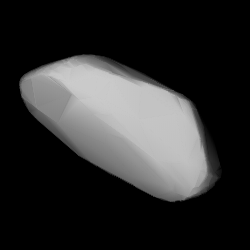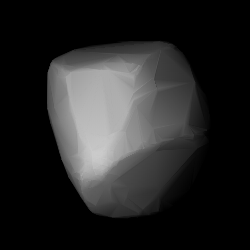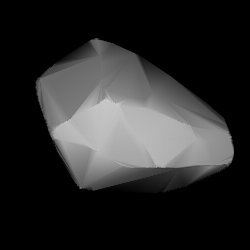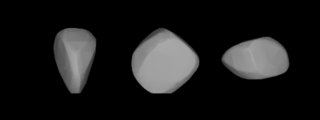Related Research Articles

1030 Vitja, provisional designation 1924 RQ, is a dark background asteroid from the outer regions of the asteroid belt, approximately 60 kilometers in diameter. It was discovered on 25 May 1924, by Soviet–Russian astronomer Vladimir Albitsky at the Simeiz Observatory on the Crimean peninsula. The asteroid was named in honor of Viktor Zaslavskij (1925–1944), a relative of the discoverer.
1059 Mussorgskia, provisional designation 1925 OA, is a background asteroid from the central regions of the asteroid belt, approximately 25 kilometers in diameter. It was discovered on 19 July 1925, by Soviet astronomer Vladimir Albitsky at the Simeiz Observatory on the Crimean peninsula. The asteroid was named for Russian composer Modest Mussorgsky. The X- or C-type asteroid has a rotation period of 5.636 hours.

1075 Helina, provisional designation 1926 SC, is a stony Eos asteroid from the outer regions of the asteroid belt, approximately 34 kilometers in diameter. It was discovered on 29 September 1926, by astronomer Grigory Neujmin at the Simeiz Observatory on the Crimean peninsula. The asteroid was named after the discoverer's son, Helij Neujmin.

1098 Hakone is a background asteroid from the central regions of the asteroid belt. The X-type asteroid has a rotation period of 7.1 hours and measures approximately 25 kilometers in diameter. Discovered by Japanese astronomer Okuro Oikawa at Tokyo Observatory in 1928, the asteroid was later named after the volcanic Mount Hakone in Japan.

1110 Jaroslawa is a bright background asteroid and rather slow rotator from the inner regions of the asteroid belt. The stony S-type asteroid has a rotation period of 97.4 hours and measures approximately 13 kilometers in diameter. It was discovered at the Simeiz Observatory on the Crimean peninsula on 10 August 1928, by astronomer Soviet Grigory Neujmin, who named it after his son, Jaroslav Grigorevich Neujmin.
1112 Polonia, provisional designation 1928 PE, is an Eoan asteroid from the outer regions of the asteroid belt, approximately 38 kilometers in diameter. Discovered by Soviet astronomer Pelageya Shajn at Simeiz in 1928, it was the first asteroid discovery made by a woman. The L-type asteroid has a long rotation period of 82.5 hours, and was named for the country of Poland.
1113 Katja, provisional designation 1928 QC, is a background asteroid from the outer regions of the asteroid belt, approximately 39 kilometers in diameter. It was discovered by Pelageya Shajn at the Simeiz Observatory in 1928, and named after Ekaterina Iosko, a staff member at the discovering observatory.
1120 Cannonia, provisional designation 1928 RV, is a stony Florian asteroid from the inner regions of the asteroid belt, approximately 10 kilometers in diameter. Discovered by Pelageya Shajn at Simeiz in 1928, it was named after American astronomer Annie Jump Cannon.
1123 Shapleya, provisional designation 1928 ST, is a stony Florian asteroid from the inner regions of the asteroid belt, approximately 11 kilometers in diameter. It was discovered on 21 September 1928, by Russian astronomer Grigory Neujmin at Simeiz Observatory on the Crimean peninsula. It was named after American astronomer Harlow Shapley.

1129 Neujmina is an Eos asteroid from the outer regions of the asteroid belt. It was discovered on 8 August 1929, by astronomer Praskoviya Parchomenko at the Simeiz Observatory on the Crimean peninsula. The stony S-type asteroid has a rotation period of 5.1 hours and measures approximately 34 kilometers in diameter. It was named after Soviet astronomer Grigory Neujmin.

1137 Raïssa is a stony background asteroid and slow rotator, approximately 22 kilometers in diameter, located in the inner regions of the asteroid belt. It was discovered by Grigory Neujmin at Simeiz Observatory in 1929, and named in memory of Raïssa Maseeva, who worked at the Pulkovo Observatory.

1140 Crimea, provisional designation 1929 YC, is a stony asteroid from the middle region of the asteroid belt, approximately 28 kilometers in diameter. It was discovered on 30 December 1929, by Soviet astronomer Grigory Neujmin at Simeiz Observatory on the Crimean peninsula, after which it was named.

1147 Stavropolis is a stony background asteroid from the inner regions of the asteroid belt. It was discovered on 11 June 1929, by Georgian–Russian astronomer Grigory Neujmin at the Simeiz Observatory on the Crimean peninsula. The S-type asteroid has a rotation period of 5.7 hours and measures approximately 14 kilometers in diameter. It was named after the Russian city of Stavropol.
1271 Isergina, provisional designation 1931 TN, is a carbonaceous background asteroid from the outer regions of the asteroid belt, approximately 45 kilometers in diameter. It was discovered on 10 October 1931, by Soviet astronomer Grigory Neujmin at the Simeiz Observatory on the Crimean peninsula. The asteroid was named after Crimean physician and friend of the discoverer, Pyotr Isergin.
1434 Margot, provisional designation 1936 FD1, is a stony Eoan asteroid from the outer regions of the asteroid belt, approximately 29 kilometers in diameter. It was discovered on 19 March 1936, by Soviet astronomer Grigory Neujmin at the Simeiz Observatory on the Crimean peninsula. The asteroid was named after Gertrud Margot Görsdorf, a friend of German astronomer of Wilhelm Gliese.

1607 Mavis, provisional designation 1950 RA, is a stony asteroid from the central region of the asteroid belt, approximately 12 kilometers in diameter. It was discovered on 3 September 1950, by South African astronomer Ernest Johnson at Johannesburg Observatory in South Africa. It was later named after the wife of astronomer Jacobus Bruwer.
1306 Scythia, provisional designation 1930 OB, is a dark Ursula asteroid from the outer regions of the asteroid belt, approximately 72 kilometers in diameter. It was discovered on 22 July 1930, by Soviet astronomer Grigory Neujmin at the Simeiz Observatory on the Crimean peninsula. The asteroid was named for the historic region of Scythia.
1734 Zhongolovich, provisional designation 1928 TJ, is a carbonaceous Dorian asteroid from the central region of the asteroid belt, approximately 28 kilometers in diameter.
1689 Floris-Jan, provisional designation 1930 SO, is a stony asteroid and a slow rotator from the inner regions of the asteroid belt, approximately 16 kilometers in diameter. Discovered by Hendrik van Gent in 1930, it was named after a contest winner of an exhibition at Leiden Observatory.

1289 Kutaïssi is a stony Koronian asteroid from the outer region of the asteroid belt. Discovered by Grigory Neujmin at Simeiz Observatory in 1933, it was later named after the Georgian city of Kutaisi. The S-type asteroid has a rotation period of 3.6 hours and measures approximately 22 kilometers in diameter.
References
- 1 2 3 4 "JPL Small-Body Database Browser: 1099 Figneria (1928 RQ)" (2017-06-02 last obs.). Jet Propulsion Laboratory . Retrieved 19 September 2017.
- 1 2 3 Schmadel, Lutz D. (2007). "(1099) Figneria". Dictionary of Minor Planet Names – (1099) Figneria. Springer Berlin Heidelberg. p. 93. doi:10.1007/978-3-540-29925-7_1100. ISBN 978-3-540-00238-3.
- 1 2 3 4 5 6 7 "LCDB Data for (1099) Figneria". Asteroid Lightcurve Database (LCDB). Retrieved 19 September 2017.
- 1 2 3 Masiero, Joseph R.; Mainzer, A. K.; Grav, T.; Bauer, J. M.; Cutri, R. M.; Dailey, J.; et al. (November 2011). "Main Belt Asteroids with WISE/NEOWISE. I. Preliminary Albedos and Diameters". The Astrophysical Journal. 741 (2): 20. arXiv: 1109.4096 . Bibcode:2011ApJ...741...68M. doi:10.1088/0004-637X/741/2/68 . Retrieved 19 September 2017.
- 1 2 3 4 Mainzer, A.; Grav, T.; Masiero, J.; Hand, E.; Bauer, J.; Tholen, D.; et al. (November 2011). "NEOWISE Studies of Spectrophotometrically Classified Asteroids: Preliminary Results". The Astrophysical Journal. 741 (2): 25. arXiv: 1109.6407 . Bibcode:2011ApJ...741...90M. doi:10.1088/0004-637X/741/2/90.
- 1 2 3 4 Usui, Fumihiko; Kuroda, Daisuke; Müller, Thomas G.; Hasegawa, Sunao; Ishiguro, Masateru; Ootsubo, Takafumi; et al. (October 2011). "Asteroid Catalog Using Akari: AKARI/IRC Mid-Infrared Asteroid Survey". Publications of the Astronomical Society of Japan. 63 (5): 1117–1138. Bibcode:2011PASJ...63.1117U. doi: 10.1093/pasj/63.5.1117 . (online, AcuA catalog p. 153)
- 1 2 3 4 Tedesco, E. F.; Noah, P. V.; Noah, M.; Price, S. D. (October 2004). "IRAS Minor Planet Survey V6.0". NASA Planetary Data System. 12: IRAS-A-FPA-3-RDR-IMPS-V6.0. Bibcode:2004PDSS...12.....T . Retrieved 22 October 2019.
- 1 2 Oey, Julian (September 2008). "Lightcurve Analysis of Asteroids from the Kingsgrove and Leura Observatories in the 2nd Half of 2007". The Minor Planet Bulletin. 35 (3): 132–135. Bibcode:2008MPBu...35..132O. ISSN 1052-8091 . Retrieved 19 September 2017.
- 1 2 3 Waszczak, Adam; Chang, Chan-Kao; Ofek, Eran O.; Laher, Russ; Masci, Frank; Levitan, David; et al. (September 2015). "Asteroid Light Curves from the Palomar Transient Factory Survey: Rotation Periods and Phase Functions from Sparse Photometry". The Astronomical Journal. 150 (3): 35. arXiv: 1504.04041 . Bibcode:2015AJ....150...75W. doi:10.1088/0004-6256/150/3/75 . Retrieved 19 September 2017.
- 1 2 3 Veres, Peter; Jedicke, Robert; Fitzsimmons, Alan; Denneau, Larry; Granvik, Mikael; Bolin, Bryce; et al. (November 2015). "Absolute magnitudes and slope parameters for 250,000 asteroids observed by Pan-STARRS PS1 - Preliminary results". Icarus. 261: 34–47. arXiv: 1506.00762 . Bibcode:2015Icar..261...34V. doi:10.1016/j.icarus.2015.08.007 . Retrieved 19 September 2017.
- 1 2 Belskaya, I. N.; Fornasier, S.; Tozzi, G. P.; Gil-Hutton, R.; Cellino, A.; Antonyuk, K.; et al. (March 2017). "Refining the asteroid taxonomy by polarimetric observations". Icarus. 284: 30–42. Bibcode:2017Icar..284...30B. doi:10.1016/j.icarus.2016.11.003. hdl: 11336/63617 . Retrieved 19 September 2017.
- 1 2 3 4 "1099 Figneria (1928 RQ)". Minor Planet Center. Retrieved 19 September 2017.